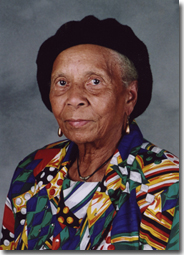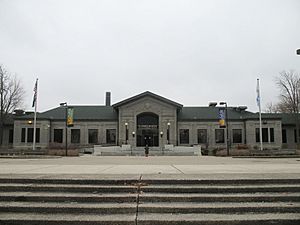Margaret Taylor-Burroughs facts for kids
Quick facts for kids
Margaret Burroughs
|
|
|---|---|

Taylor-Burroughs in 2006
|
|
| Born |
Victoria Margaret Taylor
November 1, 1915 St. Rose, Louisiana, U.S.
|
| Died | November 21, 2010 (aged 95) |
| Education | |
| Organization | |
| Spouse(s) | Bernard Goss Charles Gordon Burroughs |
| Children | 2 |
| Awards |
|
Margaret Taylor-Burroughs (born November 1, 1915 – died November 21, 2010) was an amazing American artist, writer, poet, and teacher. She was also a big helper in organizing art events and places. She is best known for helping to start the DuSable Museum of African American History in Chicago. This museum was first called the Ebony Museum of Chicago.
Margaret Burroughs was very active in the African-American community. She also helped create the South Side Community Art Center. When it opened in 1941, the First Lady of the United States, Eleanor Roosevelt, was there! Margaret was only 23 years old then, and she was the youngest person on the center's board of directors. She taught for many years at DuSable High School. Margaret Burroughs wrote many books and poems, especially for children. She wanted kids to learn about their culture and to love art. She also started the Lake Meadows Art Fair in Chicago in the 1950s.
Contents
Early Life and Education
Margaret Burroughs was born Victoria Margaret Taylor in St. Rose, Louisiana. Her father worked as a farmer and at a railroad warehouse. She grew up in a Catholic family.
In 1920, when she was five years old, her family moved to Chicago. She went to Englewood High School there. A famous poet named Gwendolyn Brooks was her classmate. Margaret and Gwendolyn both joined the NAACP Youth Council, which worked for civil rights.
Margaret became a teacher after studying at Chicago Teachers College in 1937. In 1939, she helped start the South Side Community Art Center. This center was a place for African American artists to show their work and for the community to gather. She continued her art studies at the School of the Art Institute of Chicago. She earned her first degree in art education in 1946 and her master's degree in 1948.
Margaret married artist Bernard Goss in 1939, but they divorced in 1947. In 1949, she married the poet Charles Gordon Burroughs. They stayed married until he passed away in 1994.
Teaching and Community Work
Margaret Taylor-Burroughs taught at DuSable High School in Chicago from 1946 to 1969. After that, she became a professor at Kennedy–King College in Chicago, teaching humanities from 1969 to 1979. She also taught about African American art and culture at Elmhurst College in 1968.
In 1985, Chicago's mayor, Harold Washington, made her a commissioner for the Chicago park district. She held this important job until 2010. Margaret Burroughs received many honors, including an honorary doctorate and the President’s Humanitarian Award in 1975.
Margaret Burroughs as an Artist
Dr. Margaret Taylor Burroughs showed her artwork in many places. Her art was displayed at the American Negro Exposition in Chicago in 1940. It was also shown at Clark Atlanta University and the San Francisco Civic Museum.
Margaret Burroughs created many of her own artworks. One of her famous pieces is a linocut (a type of printmaking) called Birthday Party. In this artwork, you can see both Black and white children celebrating together. They are not separate; they are all mixed together around a table, waiting for birthday cake.
The Art Institute of Chicago described Birthday Party by saying that Margaret Burroughs often chose themes about family, community, and history in her art and writing. She once said, "Art is communication. I wish my art to speak not only for my people - but for all humanity." Birthday Party shows this idea perfectly. It shows Black and white children dancing and mothers cutting cake, like neighbors and family enjoying a special day. This artwork shows Margaret's belief that "the color of skin is a minor difference among men which has been stretched beyond its importance."
In some of her artworks, Burroughs showed people with faces that were half Black and half white. In The Faces of My People, she carved five people looking at the viewer. Some of them have faces that are half Black and half white. While she wanted to show Black and white communities coming together, she also showed that sometimes there are things that keep them apart. In The Faces of My People, no one is looking at each other, which can suggest they feel disconnected. This artwork also deals with how different people can be. A magazine called Collector said that Burroughs saw her art as a way to bring people together. This picture of different people shows how much she believed in respect and understanding for everyone.
Another artwork, My People, also shows faces that are half Black and half white. This woodcut print shows four different faces, all with the same half Black and half white split. The women in the picture are very close together, which might mean they understand each other's experiences. My People focuses on a common challenge that all the women in the picture share.
Founding the DuSable Museum
Margaret and her husband Charles did something amazing: they co-founded what is now the DuSable Museum of African American History in Chicago in 1961. It was first called the Ebony Museum of Negro History and Art. It started right in the living room of their own house at 3806 S. Michigan Avenue in the Bronzeville neighborhood. Margaret Taylor-Burroughs was the museum's first Executive Director.
She was very proud that the museum started from regular people in the community. She said, "We're the only one that grew out of the Indigenous Black community. We weren't started by anybody downtown; we were started by ordinary folks." Margaret was the executive director until she retired in 1985. After that, she was named director emeritus, which means she was still active in helping the museum and raising money for it.
The museum moved to its current location in Washington Park in 1973. Today, it is the oldest museum dedicated to Black culture in the United States. Both the current museum building and the Burroughs' old home are now listed on the National Register of Historic Places. Their house is also a special Chicago landmark.
Margaret Burroughs was inspired by many important people, like Harriet Tubman, Sojourner Truth, Frederick Douglass, and W.E.B. Du Bois. She really admired W.E.B. Du Bois and worked to bring him to Chicago to speak to people. She believed in his message that it was wrong to put down a whole group of people.
Death
Margaret Burroughs passed away in Chicago on November 21, 2010.
Awards and Honors
Margaret Burroughs received many awards for her art and community work:
- 1973: Young Women's Christian Association leadership award for excellence in art.
- 1975: The President's Humanitarian Award.
- 1988: The Lifetime Achievement Award by the Women's Caucus for Art.
- 1989: The Paul Robeson Award.
- 2010: The Legends and Legacy Award from the Art Institute of Chicago.
- 2015: She was honored and added to the Chicago Literary Hall of Fame.
- On August 12, 2015, the Chicago Park District decided to rename 31st Street Beach after Margaret Taylor-Burroughs. This was because she had served as a commissioner on the park board for twenty-five years.
Selected Writings
Margaret Burroughs was a talented writer. Here are some of her books:
- Jasper, the drummin' boy (1947)
- Whip me whop me pudding, and other stories of Riley Rabbit and his fabulous friends (1966)
- What shall I tell my children who are Black? (1968)
- Did you feed my cow? Street games, chants, and rhymes (1969)
- For Malcolm; poems on the life and the death of Malcolm X (1969) - she edited this book with Dudley Randall.
- Africa, my Africa (1970)
- His name was Du Sable and he was the first (1990)
- The tallest tree in the forest (1998)
Images for kids
See also
 In Spanish: Margaret Taylor-Burroughs para niños
In Spanish: Margaret Taylor-Burroughs para niños








